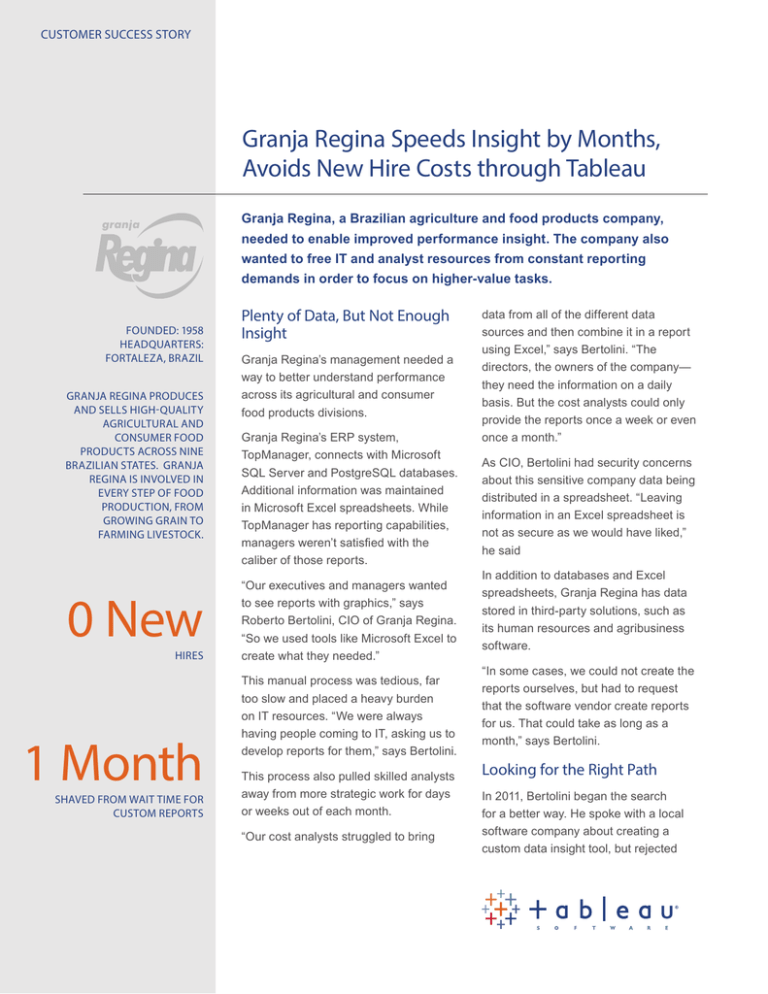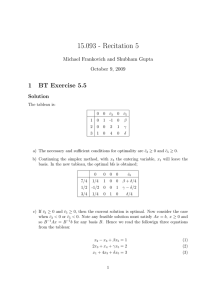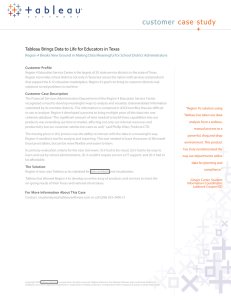
CUSTOMER SUCCESS STORY
Granja Regina Speeds Insight by Months,
Avoids New Hire Costs through Tableau
Granja Regina, a Brazilian agriculture and food products company,
needed to enable improved performance insight. The company also
wanted to free IT and analyst resources from constant reporting
demands in order to focus on higher-value tasks.
FOUNDED: 1958
HEADQUARTERS:
FORTALEZA, BRAZIL
GRANJA REGINA PRODUCES
AND SELLS HIGH-QUALITY
AGRICULTURAL AND
CONSUMER FOOD
PRODUCTS ACROSS NINE
BRAZILIAN STATES. GRANJA
REGINA IS INVOLVED IN
EVERY STEP OF FOOD
PRODUCTION, FROM
GROWING GRAIN TO
FARMING LIVESTOCK.
0 New
HIRES
1 Month
SHAVED FROM WAIT TIME FOR
CUSTOM REPORTS
Plenty of Data, But Not Enough
Insight
Granja Regina’s management needed a
way to better understand performance
across its agricultural and consumer
food products divisions.
Granja Regina’s ERP system,
TopManager, connects with Microsoft
SQL Server and PostgreSQL databases.
Additional information was maintained
in Microsoft Excel spreadsheets. While
TopManager has reporting capabilities,
managers weren’t satisfied with the
caliber of those reports.
“Our executives and managers wanted
to see reports with graphics,” says
Roberto Bertolini, CIO of Granja Regina.
“So we used tools like Microsoft Excel to
create what they needed.”
This manual process was tedious, far
too slow and placed a heavy burden
on IT resources. “We were always
having people coming to IT, asking us to
develop reports for them,” says Bertolini.
This process also pulled skilled analysts
away from more strategic work for days
or weeks out of each month.
“Our cost analysts struggled to bring
data from all of the different data
sources and then combine it in a report
using Excel,” says Bertolini. “The
directors, the owners of the company—
they need the information on a daily
basis. But the cost analysts could only
provide the reports once a week or even
once a month.”
As CIO, Bertolini had security concerns
about this sensitive company data being
distributed in a spreadsheet. “Leaving
information in an Excel spreadsheet is
not as secure as we would have liked,”
he said
In addition to databases and Excel
spreadsheets, Granja Regina has data
stored in third-party solutions, such as
its human resources and agribusiness
software.
“In some cases, we could not create the
reports ourselves, but had to request
that the software vendor create reports
for us. That could take as long as a
month,” says Bertolini.
Looking for the Right Path
In 2011, Bertolini began the search
for a better way. He spoke with a local
software company about creating a
custom data insight tool, but rejected
that idea due to the cost and time
involved.
Bertolini then considered QlikView from
QlikTech and the Pentaho BI Platform
with Pentaho Interactive Reporting.
Neither tool was exactly what Granja
Regina needed.
“All of the data
sources—
SQL Server,
PostgreSQL,
Excel—it was all
easy to bring
together and see
in Tableau.”
— Roberto Bertolini, CIO of
Granja Regina
“QlikView was cheaper than Pentaho,
but you need SQL skills, so our
managers would not be able to do things
for themselves. Pentaho had a better
user interface, but implementation would
have been very difficult,” says Bertolini.
Bertolini was invited to a Tableau
demonstration held by local software
reseller, PATH.
“Most of the CIOs in our city, Fortaleza,
attended this meeting. PATH showed
the capabilities and features of Tableau,
and I was interested right away,” says
Bertolini.
“It Was Very Easy”
Bertolini invited PATH to come to
Granja Regina to demonstrate Tableau
to company stakeholders. After the
demonstration, Granja Regina decided
that Tableau Server was the solution
he’d been looking for. The company
deployed Tableau Server in December
2012.
“It was easy to connect and blend data
from our various data sources,” says
Bertolini.
He points out that the company’s
databases were already clean and wellstructured. “Our DBA here didn’t have to
work much [on implementing Tableau],
because the sources were already good
for playing with Tableau. All of the data
sources—SQL Server, PostgreSQL,
Excel—it was all easy to bring together
and see in Tableau.”
Granja Regina sent two IT resources
and ten cost analysts and managers to
training through PATH. “They learned
how to use Tableau very quickly,” says
Bertolini.
After the training, the team got to
work creating data visualizations and
dashboard reports. “Most views took
only a day or two days to create. The
longest any of the reports took to create
was three days,” says Bertolini.
The team then validated that the Tableau
reports addressed the questions that
management hoped to answer. Once the
dashboards were approved, the IT team
published them to Tableau Server.
“We were done with everything from
deployment to publishing the first set
of reports by the end of January,” says
Bertolini.
Asking Questions They Might
Not Have Asked in The Past
Instead of waiting days, weeks, even
months for reports that could be outof-date by the time they were received,
Granja Regina leadership can see
reports—updated daily—anytime they
wish, quickly and securely.
“Now all of the data is integrated in a
secure database, but the visualizations
and reports are available—not just
for that one user who has the Excel
spreadsheet, but to anyone to whom
we’ve granted the proper access to
reports through Tableau Server,” says
Bertolini. Granja Regina uses Active
Directory to control access to Server.
Four company directors are accessing
Tableau dashboards using their
iPads; Bertolini is working to provide
mobile access to other Granja Regina
employees. “Our sales managers
already use tablets to take orders,
and we’re working on sales target
goal reports in Tableau that our sales
managers will be able to access through
their tablets when they’re out working,”
says Bertolini.
“Now we have a
BI tool that is
being used
directly by the
business people.”
— Roberto Bertolini, CIO of
Granja Regina
“Company directors and managers are
asking questions that they might not
have asked in the past because they
couldn’t analyze the information that
would have prompted those questions,”
says Bertolini.
“Now we have a BI tool that is being
used directly by the business people.”
And those planning meetings that used
to be held only once each month, due
to how long it took the cost analysts to
prepare reports? “Now with Tableau we
have that information updated on a daily
basis, and those meetings are being
held once a week,” says Bertolini.
Freedom to Focus on HigherValue Work
Now that a number of dashboard reports
have been published to Server, the IT
team is no longer diverted from core
efforts by constant requests for reports.
“The IT team doesn’t have to work much
to build those reports. It’s already done
and available in Tableau,” Bertolini says.
Today, his IT team is able to focus on
core efforts such as user support and
database maintenance.
“Tableau is our Business Intelligence
software. It’s between the managers and
the cost analysts—IT isn’t involved as
much. They don’t depend on us.”
Even better, Bertolini estimates that
implementing Tableau has allowed him
to avoid hiring several additional IT
employees—which he would have been
forced to do simply to keep up with the
internal reporting demands.
Cost analysts are saving days and
weeks of time that used to be spent
manually creating reports.
“Managers are making better use of
the cost analysts’ time,” adds Bertolini.
“Our cost analysts can really work as
analysts.”
837 N 34TH ST, SUITE 400
SEATTLE WA 98103
(206) 633-3400
tableausoftware.com
© Copyright Tableau Software, Inc. 2013. All rights reserved. Tableau Software, the Tableau Software logo, and Visual Analysis
for Databases are either registered trademarks or trademarks of Tableau Software, Incorporated. Other company or product
names may be the trademarks of their respective owners.





